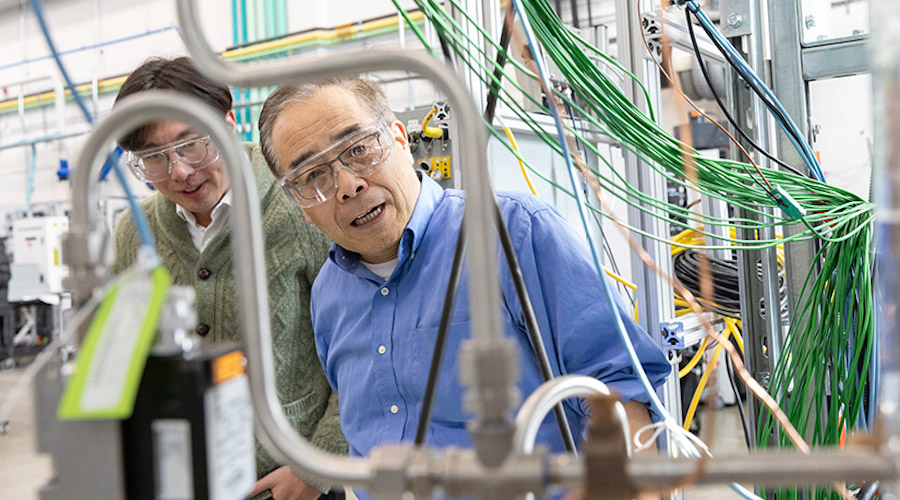New technology uses sand to store renewable energy
New technology uses sand to store renewable energy - MINING.COM MINING.com


Sustainable Development Goals and Long-Duration Energy Storage

A laboratory-scale prototype validated the technology and allowed researchers to create a computer model that shows a commercial-scale device would retain more than 95% of its heat for at least five days.
Long-duration energy storage is crucial for achieving carbon reduction goals outlined in the Sustainable Development Goals (SDGs). While lithium-ion batteries dominate the market with storage capabilities of two to four hours, there is a need for devices that can store energy for days. Jeffrey Gifford, a postdoctoral fellow at NREL involved in the development, emphasized the importance of long-duration energy storage in meeting carbon reduction goals.
One promising technology for long-duration energy storage is particle thermal energy storage (TES). Unlike lithium-ion batteries, TES does not rely on rare earth metals or materials with complex and unsustainable supply chains. This makes TES a more sustainable option for energy storage. Additionally, TES media such as sand, concrete, and rocks have the ability to retain heat effectively, with sand being the cheapest option.
Lower Cost and Advantages of Sand as a Storage Medium
TES using sand as a storage medium offers several advantages, including lower cost compared to rival technologies. Zhiwen Ma, the head researcher, has calculated that sand is the most cost-effective option for energy storage when compared to compressed air energy storage (CAES), pumped hydropower, and two types of batteries.
CAES and pumped hydropower can only store energy for tens of hours and have higher costs per kilowatt-hour. In contrast, sand as a storage medium can provide energy storage lasting hundreds of hours at a cost ranging from $4 to $10 per kilowatt-hour. The heat required for sand-based TES can be generated using off-peak, low-price electricity, further reducing costs.
Molten salts are currently used for temporary energy storage but have limitations in terms of temperature range and heat retention. Sand, on the other hand, can retain considerably more heat, making it suitable for power generation or replacing fossil fuels for industrial heat.
Expanding Energy Storage Capacity with Sand
One of the key advantages of sand-based TES is its scalability. Expanding the amount of energy that can be stored simply involves adding more sand, which incurs only marginal costs. This makes sand-based TES a cost-effective solution for increasing storage capacity.
While batteries are effective for short-term storage (minutes to hours) and hydrogen is suitable for long-term storage (months), there is currently no viable option for storage in the range of multiple hours to two weeks. Sand-based TES fills this gap by providing a cost-effective solution for medium-term energy storage.
The upfront cost of the components needed to convert superheated sand back to electricity is required. However, once this cost is covered, adding more sand for increased duration becomes much cheaper than adding more batteries.
SDGs, Targets, and Indicators
-
SDG 7: Affordable and Clean Energy
- Target 7.1: By 2030, ensure universal access to affordable, reliable, and modern energy services.
- Target 7.2: By 2030, increase substantially the share of renewable energy in the global energy mix.
- Indicator: Percentage of population with access to affordable and reliable energy services.
- Indicator: Renewable energy share in the total energy consumption.
-
SDG 9: Industry, Innovation, and Infrastructure
- Target 9.4: By 2030, upgrade infrastructure and retrofit industries to make them sustainable, with increased resource-use efficiency and greater adoption of clean and environmentally sound technologies and industrial processes.
- Indicator: Proportion of industries using sustainable practices and technologies.
-
SDG 13: Climate Action
- Target 13.2: Integrate climate change measures into national policies, strategies, and planning.
- Indicator: Number of countries that have integrated climate change measures into national policies, strategies, and planning.
| SDGs | Targets | Indicators |
|---|---|---|
| SDG 7: Affordable and Clean Energy | Target 7.1: By 2030, ensure universal access to affordable, reliable, and modern energy services. | Percentage of population with access to affordable and reliable energy services. |
| SDG 7: Affordable and Clean Energy | Target 7.2: By 2030, increase substantially the share of renewable energy in the global energy mix. | Renewable energy share in the total energy consumption. |
| SDG 9: Industry, Innovation, and Infrastructure | Target 9.4: By 2030, upgrade infrastructure and retrofit industries to make them sustainable, with increased resource-use efficiency and greater adoption of clean and environmentally sound technologies and industrial processes. | Proportion of industries using sustainable practices and technologies. |
| SDG 13: Climate Action | Target 13.2: Integrate climate change measures into national policies, strategies, and planning. | Number of countries that have integrated climate change measures into national policies, strategies, and planning. |
1. Which SDGs are addressed or connected to the issues highlighted in the article?
The issues highlighted in the article are connected to SDG 7 (Affordable and Clean Energy), SDG 9 (Industry, Innovation, and Infrastructure), and SDG 13 (Climate Action).
2. What specific targets under those SDGs can be identified based on the article’s content?
- Under SDG 7, the specific targets that can be identified are Target 7.1 (universal access to affordable, reliable, and modern energy services) and Target 7.2 (increase the share of renewable energy in the global energy mix).
- Under SDG 9, the specific target that can be identified is Target 9.4 (upgrade infrastructure and retrofit industries to make them sustainable).
- Under SDG 13, the specific target that can be identified is Target 13.2 (integrate climate change measures into national policies, strategies, and planning).
3. Are there any indicators mentioned or implied in the article that can be used to measure progress towards the identified targets?
Yes, there are indicators mentioned or implied in the article that can be used to measure progress towards the identified targets:
- Percentage of population with access to affordable and reliable energy services can be used as an indicator for measuring progress towards Target 7.1.
- Renewable energy share in the total energy consumption can be used as an indicator for measuring progress towards Target 7.2.
- Proportion of industries using sustainable practices and technologies can be used as an indicator for measuring progress towards Target 9.4.
- Number of countries that have integrated climate change measures into national policies, strategies, and planning can be used as an indicator for measuring progress towards Target 13.2.
4. Table: SDGs, Targets, and Indicators
| SDGs | Targets | Indicators |
|---|---|---|
| SDG 7: Affordable and Clean Energy | Target 7.1: By 2030, ensure universal access to affordable, reliable, and modern energy services. | Percentage of population with access to affordable and reliable energy services. |
| SDG 7: Affordable and Clean Energy | Target 7.2: By 2030, increase substantially the share of renewable energy in the global energy mix. | Renewable energy share in the total energy consumption. |
| SDG 9: Industry, Innovation, and Infrastructure | Target 9.4: By 2030, upgrade infrastructure and retrofit industries to make them sustainable, with increased resource-use efficiency and greater adoption of clean and environmentally sound technologies and industrial processes. | Proportion of industries using sustainable practices and technologies. |
| SDG 13: Climate Action | Target 13.2: Integrate climate change measures into national policies, strategies, and planning. | Number of countries that have integrated climate change measures into national policies, strategies, and planning. |
Behold! This splendid article springs forth from the wellspring of knowledge, shaped by a wondrous proprietary AI technology that delved into a vast ocean of data, illuminating the path towards the Sustainable Development Goals. Remember that all rights are reserved by SDG Investors LLC, empowering us to champion progress together.
Source: mining.com

Join us, as fellow seekers of change, on a transformative journey at https://sdgtalks.ai/welcome, where you can become a member and actively contribute to shaping a brighter future.







